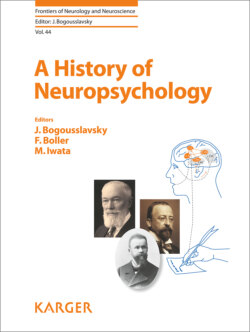Читать книгу A History of Neuropsychology - Группа авторов - Страница 33
На сайте Литреса книга снята с продажи.
From Descriptive Single Case Reports to First Neuroanatomical Correlates
ОглавлениеThe original case of Phineas Gage, a 25-year-old railroad foreman who was caught in a dramatic explosion that resulted in a 3 cm-thick tamping iron penetrating his left cheek, skull, and brain, remains the classic introduction to the field of behavioral disorders [2, 3]. Gage survived and recovered without any motor or cognitive impairment. However, “he was no longer Gage,” according to his friends [2]. Formerly, a responsible and socially well-adapted individual, he became irreverent and capricious, could not hold a job and died 12 years later under the custody of his family. Harlow published a very comprehensive description of the behavioral changes occurring after Gage’s accident, which included a several-year-long follow-up of the patient and testimony of relatives and friends [2]. He also presumed that these behavioral modifications were associated with lesions to a particular region of the frontal cortex, making it one of the earliest correlations between behavioral disorders and neuroanatomy.
In addition to medical records, behavioral changes have occasionally become the object of public perception through artistic acknowledgment and penal proceedings. Contemporary to Phineas Gage, Eadweard Muybridge, a bookseller established in San Francisco, survived a stagecoach accident in 1860 [6]. Again, this patient recovered physically and intellectually but his personality transformed dramatically. He changed the spelling of his name dozens of times and was even charged with the murder of a man suspected of having an affair with his wife. Yet, this lesion triggered a new artistic expression and re-oriented his career: He became a pioneering photographer and developed the “zoopraxiscope,” a precursor of motion pictures. Based on visual symptoms and the loss of smell and taste, Eadweard Muybridge’s brain lesion is assumed to have occurred in the orbitofrontal cortex.
These 2 case reports of trauma established the relationship between lesions to a specific brain area and acquired behavioral deficits that spared intellectual abilities. A few decades later and with the development of neurosurgical procedures, neuroanatomical correlates became accessible to more specific investigation and further underscored the relevance of behavior assessment. One of the sessions at the 2nd International Neurological Congress in London (1935) was thus dedicated to the functions of the frontal lobe [7], and included the well-documented follow-up of patient Joe A., the first bilateral frontal lobectomy case with long survival [8]. Intellectual performance in this patient was assessed using psychometric testing, whereas behavioral status remained at the descriptive level, relying (as for almost all cases of that era) mainly on the neurologist’s observations and heteroanamnesis. Following the resection, Joe A. became logorrheic, self-absorbed, puerile and distractible, with perseverations and sudden mood changes. Whilst Brickner showed severe deterioration in Joe A.’s behavior after surgery, Hebb and Penfield reported a 27-year-old patient who improved after partial bilateral frontal lobectomy [9, 10]. Following a traumatic brain injury to the frontal poles at the age of 16 years, K. M. suffered from severe epileptic seizures. During interictal states, he was described as “childish, violent, stubborn and destructive” by his relatives and the whole neighborhood. After operation, he became “normal in every way” [9]. The 6-year follow-up showed that he had been independent in his daily life activities and successful in finding jobs since his discharge from the army. Although he frequently changed jobs, he was able to save for the future. Here, K. M.’s post-surgical behavioral improvement was evaluated through information given by his parents and his brother, as well as through the “independent testimony of 3 residents of the village,” namely a taxi driver, a storekeeper, and a waitress.
Two decades later, Luria et al. [11] went a step further and published a seminal detailed experimental analysis about the impairment in behavioral regulation after the removal of part of a left frontal meningioma. Patient Zav underwent a full test battery addressing different modalities (verbal, non-verbal, symbolic instructions) and assessing various levels of behavioral regulation (apprehension of instructions, evaluation of errors). This study also introduced the innovative concept of “orienting reaction,” that is, an autonomic signal based on previously registered feedbacks produced by the outcomes of actions, which is assumed to be disturbed in patient Zav. The recording of vascular and galvanic skin responses (GSR) indeed showed the absence of activation during tasks and reinforced the hypothesis of a lack of error utilization underlying behavioral regulation and decision-making impairments. As described below, this pioneering approach was made popular 30 years later with the “somatic marker hypothesis” [12, 13].
Advances in neurosurgery and the London congress also led to the rise of lobotomy. Initiated by Swiss psychiatrist Gottlieb Burckhardt as early as 1888 and later extensively implemented by Egas Moniz and Walter Freeman, the controversial “psychosurgery” consisted mainly of frontal lobotomy, that is, the (minimal-to-extensive) deletion of the fibers connecting the frontal areas with the rest of the brain, to decrease symptoms of mental illness [14, 15]. Post-surgery patients typically showed apathy, loss of initiative, and a decrease in social interactions. Not only were these behavioral characteristics just outlined and their follow-up was brief, but they were also certainly biased by pre-existing mental disorders.
